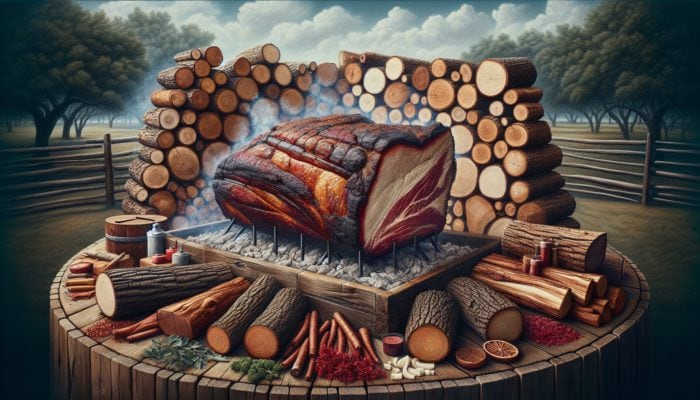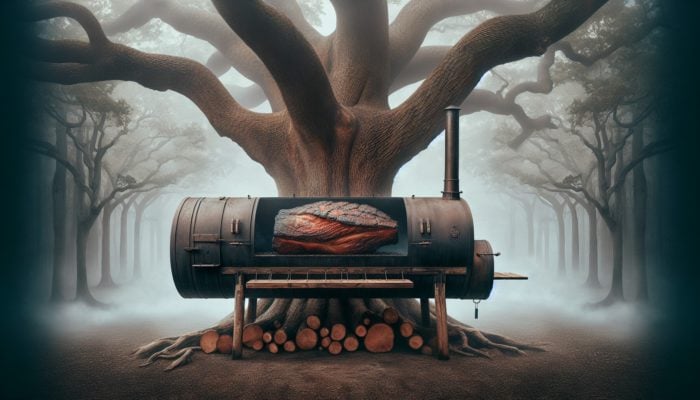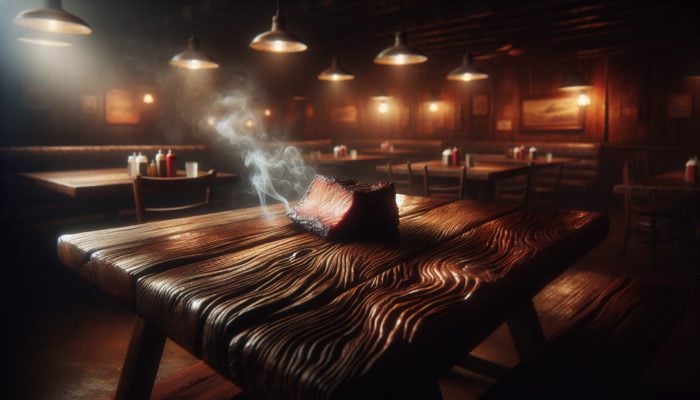Exploring the Best Oak Varieties for Smoking Flavorful Brisket
Diverse Oak Varieties to Enhance Your Barbecue

Best Woods for Smoking Brisket: When it comes to smoking brisket, the choice of wood has a significant influence on the overall flavor profile. Oak wood is a standout choice among barbecue enthusiasts, providing a solid foundation for rich, smoky flavors. The main types of oak used in smoking include white oak, red oak, and live oak, each offering distinct characteristics that elevate the smoking experience to a new level. White oak is renowned for its robust and slightly sweet flavor, which pairs beautifully with the savory taste of brisket, resulting in a well-rounded smoke that enhances rather than overwhelms. In regions like the Midwest, where this species thrives, it has become a favored option among many seasoned pitmasters.
In contrast, red oak provides a sharper, more intense flavor, enriching the brisket's natural taste profile while necessitating careful usage to avoid overpowering the palate. Meanwhile, live oak, commonly found in southern states such as Texas and Florida, offers a medium smoke strength with a hint of sweetness, making it particularly well-suited for low-and-slow cooking. Each of these oak varieties not only influences the flavor but also plays a crucial role in developing the smoke ring and bark, two essential elements that contribute to achieving the perfect barbecue finish.
Perfectly Pairing Oak with Brisket for Enhanced Flavor
The pairing of oak wood with brisket is truly a match made in culinary heaven. The strong, versatile flavor profile of oak complements the rich, fatty characteristics of brisket, enhancing its natural juiciness without overshadowing it. When smoked at the right temperature, oak generates a clean, flavor-enhancing smoke that penetrates the meat deeply, creating a delightful balance that barbecue enthusiasts savor—as the brisket cooks, the fat renders and melds with the essence of oak, forming a delectable crust that is both crispy and flavorful. This remarkable synergy not only amplifies the taste of the brisket but also adds a beautiful layer of complexity that every barbecue aficionado seeks. Many experienced pitmasters recommend using oak during the initial smoking phase to lay down a bold foundation of flavor, followed by a transition to milder woods, such as fruitwood, in the final hours to refine the overall taste further and achieve the perfect finish.
Listen With Me?
Availability of Oak Wood for Smoking Across the U.S.
One of the significant advantages of choosing oak for smoking brisket is its wide availability throughout the United States. From the dense forests of the Northeast to the sprawling woodlands of the South, oak is a common sight, making it easy for both home cooks and professional pitmasters to source high-quality wood. Many local barbecue supply stores and lumberyards offer oak in various forms, including chunks, chips, and logs, catering to different smoking preferences. The popularity of oak extends beyond just brisket; it is also widely used for smoking other meats, making it a staple essential in the grilling community. With the ease of access to high-quality oak wood, anyone can achieve that signature smoky flavor at home, regardless of their location or level of expertise, ensuring that the art of smoking brisket is accessible to all.
Hickory: The Ultimate Choice for Bold Brisket Smoking

Discovering Hickory's Strong, Pungent Flavor for Brisket
For barbecue enthusiasts who revel in bold, smoky flavors, hickory emerges as the ultimate choice for smoking brisket. Esteemed for its strong, pungent taste, hickory offers a robust flavor profile that can elevate a simple brisket into a flavor-packed masterpiece. This wood is particularly beloved in Southern barbecue traditions, where its hearty smoke enhances the richness of the meat. However, it’s essential to wield hickory with care; its intensity can easily overshadow the brisket’s natural flavors if used excessively. Many seasoned pitmasters recommend blending hickory with milder woods, such as apple or cherry, to achieve a balanced smoke that enhances the brisket's flavor without overpowering it. This combination enables a more nuanced flavor experience that can satisfy even the most discerning palates.
Understanding Hickory's Impact on Brisket Cooking Time
The influence of hickory on cooking time is significant and cannot be understated. Its strong smoke can accelerate the development of a crust, known as the bark, while simultaneously infusing the meat with deep, rich flavors. However, this intensity also demands careful timing and temperature management. Many experts suggest maintaining a lower heat—around 225°F to 250°F—when utilizing hickory, as this allows for a slow infusion of flavor that ensures tenderness in the brisket. The cooking time may extend depending on the thickness of the brisket, but the reward is a delectably smoky experience that resonates with flavor. To achieve optimal tenderness, consider wrapping the brisket in butcher paper or foil partway through the cooking process, allowing the meat to retain moisture while still benefiting from the unique flavor characteristics of hickory.
Regions in the U.S. Where Hickory is Abundant

Hickory trees are widely distributed across the United States, particularly in the Southeast and Midwest, making them a popular choice for many barbecue enthusiasts. States like North Carolina and Tennessee are renowned for their hickory forests, and this wood has become synonymous with their rich barbecue traditions. Local suppliers in these regions often carry hickory in various forms, including chips, chunks, and logs, ensuring that anyone can harness its robust flavor for smoking brisket. Understanding the regional nuances of hickory can significantly enhance the smoking experience, as different areas might have varying hickory types, each imparting unique flavors that can elevate your barbecue creations.
Essential Steps for Proper Hickory Wood Preparation
Preparing hickory wood for smoking involves several critical steps to ensure safety and maximize flavor. First and foremost, it is vital to ensure that the wood is properly seasoned; fresh hickory can produce acrid smoke that might ruin the brisket. Ideally, hickory should be dried for at least six months to a year before use. When cutting hickory, aim for uniform pieces that promote even burning. Chips, chunks, or logs can all work for smoking, but each size will affect the smoking duration and intensity. Soaking hickory chips in water for about 30 minutes before use can help regulate the burn rate, providing a slower release of smoke that envelops the brisket without overpowering it. This preparation ensures that the hickory wood contributes its distinctive flavor seamlessly to the smoking process.
Exploring Alternatives to Hickory for Unique Brisket Flavor
If the strong flavor of hickory seems daunting, several alternatives can offer distinctive flavor profiles that are suitable for smoking brisket. Mesquite, with its earthy essence, can offer a bold flavor, though it requires similar caution to hickory due to its intensity. Alternatively, fruitwoods such as apple or cherry provide mild, sweet smoke that complements the brisket's natural richness. Each wood type brings its unique aroma and taste, allowing for creativity in the smoking process. Testing various combinations can lead to remarkable discoveries, adding depth and variety to your barbecue repertoire while pleasing the palate of everyone who enjoys your smoked creations.
Pecan: A Unique Nutty Flavor for Smoking Brisket
Uncovering Pecan's Distinctive Nutty Flavor Profile
Pecan wood stands out in the smoking world for its unique, nutty flavor that adds a delightful twist to brisket. This wood offers a milder profile compared to hickory or mesquite, making it an excellent choice for those who prefer a subtle enhancement rather than an overwhelming smoke. The inherent sweetness of pecan smoke harmonizes beautifully with the rich, fatty layers of brisket, leading to a more balanced and delightful flavor experience. As pecan wood is often harvested from orchards, its availability is widespread, particularly in areas with a tradition of pecan farming, ensuring that this delightful wood is accessible to many barbecue enthusiasts.
Enhancing Brisket Texture with Pecan Smoking
Utilizing pecan wood for smoking brisket not only enhances flavor but also significantly impacts the texture of the meat. As the brisket absorbs the gentle, nutty smoke, it becomes tender and juicy, often yielding a more succulent bite. The smoking process with pecan promotes an even cook, which helps break down tougher connective tissues in the meat, leading to that desired melt-in-your-mouth quality. The result is a brisket that showcases both tenderness and rich smokiness, making for an irresistible feast that is sure to impress friends and family alike.
Availability of Pecan Wood Across the United States
Pecan wood is readily available across the United States, particularly in regions known for pecan cultivation such as Texas, Georgia, and Louisiana. Many local suppliers, barbecue stores, and even orchards offer pecan wood in various forms, from chips to logs, allowing enthusiasts to choose according to their smoking preferences. Its widespread availability ensures that anyone can experiment with pecan smoke in their barbecue endeavors, adding a unique flavor to their brisket with relative ease. This accessibility makes pecan a beloved choice for many who seek to elevate their smoking game.
The Mild Intensity of Pecan Smoke
Pecan wood smoke possesses a mild intensity that makes it versatile for various smoking times and personal preferences. For those who appreciate a lighter touch, pecan can be used alone, providing just enough flavor to enhance the brisket without overpowering it. However, if a stronger smoke is desired, pecan can be combined with more robust woods, such as hickory or mesquite, creating a complex flavor profile that still highlights the brisket’s natural taste. Adjusting the proportion of pecan to stronger woods allows for customization, catering to diverse palates and smoking styles, making the smoking process an exciting adventure of flavor exploration.
Key Preparations for Pecan Wood Smoking
Preparing pecan wood for smoking involves methods similar to those used for other types of wood, but with a focus on ensuring optimal flavor. Season the pecan wood for a minimum of six months to allow it to dry adequately, preventing any bitterness from fresh wood. When cutting, aim for consistent chunks to promote even burning during the smoking process. Soaking pecan chips is optional, but it can enhance the smoking experience by prolonging the smoke release and ensuring a gradual infusion of flavor. Proper preparation guarantees that the pecan wood contributes its delightful flavor without introducing undesirable characteristics, resulting in a perfectly smoked brisket that will be the star of any gathering.
Mesquite: The Bold Choice for Brisket Smoking
Unleashing the Intense Flavor of Mesquite in Brisket
Mesquite is revered for its intensely bold and earthy flavor, making it a legendary choice among barbecue aficionados. Its unique profile can elevate brisket to new heights, but caution is advised; its strength can easily dominate the dish if not used judiciously. Mesquite’s robust taste is particularly popular in Texan barbecue, where it’s often the wood of choice for producing a deep, rich smoke that complements the brisket’s natural flavors. The challenge lies in balancing this intensity, enabling the meat's inherent qualities to shine through while still enjoying mesquite's distinctive characteristics. Mastering the use of mesquite requires skill and knowledge, but the results can be extraordinarily rewarding.
Understanding Mesquite's Impact on Brisket Cooking
Successful smoking with mesquite requires a thorough understanding of its impact on the heat and flavor of brisket. The wood burns hotter and faster than other types, which can lead to quicker cooking times, but also risks drying out the meat if not monitored carefully. Cooking at lower temperatures—typically around 225°F to 250°F—allows for a gradual infusion of mesquite flavor while ensuring the brisket remains moist and tender. Utilizing a method known as the Texas crutch, where the brisket is wrapped halfway through cooking, can help lock in moisture, making it easier to achieve the desired texture and flavor from the mesquite wood. This technique is especially useful for those seeking to create a perfect brisket experience.
Regions in the U.S. Known for Mesquite Availability
Mesquite wood is predominantly found in the Southwestern United States, with Texas being its most famous region for barbecue. The mesquite tree thrives in arid climates, making it a common sight in Texas’s open landscapes and offering a unique flavor profile that is cherished by many. This wood is easily sourced locally, and many barbecue purveyors offer it in various forms, ranging from chips to logs. Understanding the regional significance of mesquite can enhance your smoking adventures, as local varieties may impart subtle flavor differences that can elevate your brisket experience to new levels of deliciousness.
Proper Preparation Techniques for Mesquite Wood
Proper preparation of mesquite wood is crucial to its successful use in smoking brisket. Like other hardwoods, mesquite should be seasoned for at least six months to ensure optimal flavor and quality. When chopping mesquite, aim for uniform sizes to promote even burning, which is essential for achieving a consistent smoke. Due to its density, mesquite burns hotter; therefore, careful monitoring of cooking temperatures is essential to prevent the brisket from drying out. Using chunks rather than chips can help maintain a steady burn, allowing for a balanced infusion of flavor without overwhelming the meat. This preparation ensures that mesquite contributes its bold qualities effectively, enhancing the overall smoking process.
Exploring Alternatives to Mesquite for Flavorful Brisket
If mesquite’s potent flavor feels too intense for your palate, several alternative woods can provide unique profiles for smoking brisket. Woods like apple and cherry offer milder, sweeter smoke that enhances the brisket’s natural flavors without overpowering them. Maple wood can contribute a subtle sweetness, making it a delightful substitute for those looking to experiment with their smoking techniques. Blending mesquite with these softer woods can also create a harmonious balance, allowing you to enjoy mesquite’s distinctive qualities while tempering its intensity, resulting in a well-rounded flavor experience that will impress your guests.
Cherry: The Sweet Flavor Profile for Brisket Smoking
Cherry Wood's Distinctive Sweet Flavor Enhances Brisket
Cherry wood is a favorite among many barbecue enthusiasts for its distinctive sweet and fruity flavor, which pairs beautifully with brisket. This wood not only enhances the taste of the meat but also imparts a lovely color, creating an appealing visual presentation that is hard to resist. The subtle sweetness of cherry smoke acts as a perfect complement to the rich, fatty brisket, offering a well-rounded flavor that appeals to a broad spectrum of palates. As a fruitwood, cherry is particularly versatile, making it ideal for those who appreciate a more nuanced smoking experience that brings out the best in the meat.
Enhancing Brisket Color with Cherry Wood Smoke
In addition to its flavor, cherry wood significantly enhances the appearance of smoked brisket. The smoke produced by cherry wood creates a beautiful, reddish hue on the meat, giving it an appetizing look that is sure to impress guests and family alike. This coloration results from the natural compounds in cherry wood, which interact with the meat during the smoking process to create a vibrant, colorful brisket that not only adds to the dish’s visual appeal but also suggests depth of flavor, enticing diners before they even take a bite. The aesthetic of a cherry-smoked brisket enhances the overall dining experience, making it a favorite choice for special occasions.
Cherry Wood Availability Across the United States
Cherry wood is widely available across the United States, particularly in regions where cherry trees are cultivated, such as the Pacific Northwest and the Midwest. Many barbecue and specialty wood suppliers offer cherry wood in various forms, including chips, chunks, and logs, making it accessible to both home cooks and professional chefs. Its popularity means that anyone looking to elevate their brisket smoking will have no trouble finding high-quality cherry wood, ensuring a delightful culinary experience that can transform ordinary meals into extraordinary ones. The accessibility of cherry wood allows anyone to experiment with its unique flavor and color, enhancing their barbecue skills.
Apple: The Mild and Sweet Choice for Brisket Smoking
Embracing Apple's Mild Flavor for a Gentle Smoking Experience
Apple wood is celebrated for its mild, slightly sweet flavor, making it an ideal choice for those who prefer a gentler smoking experience. The soft smoke of apple wood complements the natural taste of brisket without overpowering it, allowing the meat's intrinsic flavors to shine through beautifully. This subtle sweetness is particularly effective in balancing the richness of the brisket, creating a harmonious flavor profile that appeals to a wide range of tastes, including those who are new to smoked meats. Apple wood is a fantastic choice for achieving that perfect delicate touch that enhances the overall eating experience.
Enhancing Brisket Tenderness with Apple Wood
When using apple wood for smoking brisket, the impact on tenderness is remarkable and well worth noting. The mild smoke enhances the cooking process, allowing the meat to retain moisture while achieving that coveted juicy texture that everyone desires. Apple wood burns at a lower temperature, which helps facilitate the slow cooking process, ensuring that the connective tissues in the brisket break down properly. This results in a tender brisket that is both flavorful and enjoyable, making apple wood an excellent choice for those seeking perfection in their barbecue endeavors. The combination of sweetness and tenderness provides an irresistible experience that keeps diners coming back for more.
Commonly Asked Questions about Smoking Brisket
What are the best woods for smoking brisket?
The best woods for smoking brisket include oak, hickory, pecan, mesquite, cherry, and apple. Each wood offers unique flavors and characteristics that can enhance the brisket's taste, making the smoking experience exciting and diverse.
How does oak wood affect brisket flavor?
Oak wood provides a strong, versatile flavor that complements the richness of brisket, enhancing its overall taste without overpowering it. Different oak varieties offer distinct profiles for smoking, providing options to suit various preferences.
Is hickory too strong for brisket?
Hickory has a bold flavor that can be intense, but when used in moderation or blended with milder woods, it can create a deliciously smoky brisket without overwhelming the meat. Understanding how to balance flavors is key.
What’s the difference between hickory and pecan for smoking?
Hickory offers a stronger, more assertive flavor, while pecan provides a milder, nuttier taste. Pecan wood can enhance the sweetness of brisket without overpowering its natural flavors, making it a great alternative for those who prefer subtlety.
Can mesquite be used for all types of meat?
Yes, mesquite can be used for various meats, but due to its strong flavor, it's best suited for beef and game. Using it sparingly or blending with milder woods can yield better results, ensuring a balanced taste.
What effect does cherry wood have on brisket color?
Cherry wood imparts a beautiful, reddish hue to the brisket, enhancing its visual appeal while adding a sweet and fruity flavor profile to the meat. This combination of flavor and color creates an enticing dish to serve.
How can I prepare wood for smoking brisket?
Season the wood for at least six months, cut it into uniform pieces, and consider soaking chips before use to prolong smoke release. Proper preparation ensures optimal flavor and quality, significantly enhancing your smoking experience.
Where can I find pecan and apple wood for smoking?
Pecan and apple wood are readily available at barbecue supply stores and local lumberyards across the U.S., particularly in regions known for fruit orchards. This accessibility makes it easy for enthusiasts to experiment with different woods.
What is the ideal smoking temperature for brisket?
The ideal smoking temperature for brisket is between 225°F and 250°F. This range allows for a slow cook, enabling the meat to absorb smoke flavor while becoming tender and juicy, resulting in an outstanding barbecue experience.
Can I mix different types of wood when smoking brisket?
Absolutely! Mixing different types of wood can create unique flavors. Combining stronger woods like hickory with milder varieties like cherry can result in a balanced smoke profile that enhances the overall taste of the brisket.



